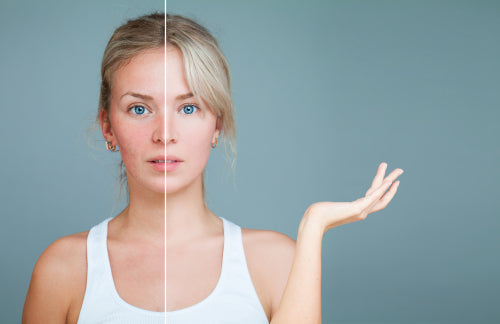Do I have ROSACEA? What can I do?

Rosacea (pronounced “roh-ZAY-sha”) basically starts as a redness on the cheeks, nose, chin or forehead. This redness can come and go, and many with rosacea have a history of frequent blushing or flushing. It is more common if you are fair-skinned. Over time, you may notice that this redness tends to become more persistent, and may resemble the look of a sunburn that doesn’t go away. Visible tiny blood vessels may appear on the face and the central facial skin could start to appear very dry. Left untreated, your face will stay red in appearance and become more sensitive. This is the time to really treat this condition and get it under control. Because, if this continues, you will start noticing not only the redness, but bumps and pimples developing. Chronically inflamed skin will thicken over time. This especially affects the area of the nose, which, in more severe cases grows swollen and bumpy. In some rosacea patients, their eyes can be affected, feeling irritated and appearing watery or bloodshot.
Rosasea typically starts to occur around the age of 30 and is more frequently diagnosed in women. However, more severe symptoms tend to be seen in men (perhaps because they often delay seeking medical help until the disorder reaches advanced stages).
While the cause of rosacea is really unknown, great treatments is now available.
So what should you do?
First and foremost, if you are starting to notice some rosacea, try to limit the things that will flare you up!
Many report that certain skin-care products or cosmetics aggravate their condition. The following ingredients can trigger irritation: alcohol, witch hazel, fragrance, menthol, peppermint and eucalyptus oil. I would avoid astringents, exfoliating agents and other types of products that may be too harsh for sensitive skin.
There are many products that may soothe and reverse mild rosacea. Chamomile and a no-sting form of vitamin C called Ascorbyl Palmitate are calming. Products with white tea and Oat Kernel extract are also good choices. Basically, look for products that advertise “calming”, “soothing”, or “gentle” ingredients.
To minimize skin irritation, try this gentle, cleansing routine developed by leading dermatologists for people with rosacea.
Using your fingertips, wash skin with a cleanser suitable for your skin type. Avoid using an abrasive washcloth or sponge, which may irritate. Rinse away cleanser with lukewarm water. Hot or cold water may cause flushing or irritation. If your face is irritated by water at any temperature, try using a soothing cream cleanser you can simply tissue off. Gently blot your face dry with a thick-pile cotton towel. Don’t rub skin, as this may cause irritation. Since stinging most often occurs on damp skin, wait 30 minutes for the face to dry completely before applying any moisturizer or sunscreen.
Moisturizer is key for preventing the burning, stinging, itching and irritation often associated with rosacea, as well as building a strong moisture barrier to help keep out impurities and irritants that may aggravate sensitive skin. Facial moisturizers have now been developed specifically for those with rosacea. They are specially formulated with ingredients intended to calm, soothe and to help prevent redness from irritation. Some also contain sheer green color neutralizers to correct the appearance of redness. Used daily, moisturizers can help soothe irritation, improve appearance and restore the skin’s proper functioning.
Corrective camouflage works wonders to help conceal rosacea symptoms. This is a special kind of make-up with a green tint. A sheer green-tinted primer is a good choice for a makeup base — it can help visually correct redness and even out skin tone. Get one with UVA/UVB protection and you’ll help shield skin from exposure that can aggravate rosacea. A protective base has another bonus, too: it helps your makeup last longer.
Daily sun protection is a must for any skin type, but anyone with rosacea should be especially vigilant. Sun exposure is a top trigger for rosacea flare-ups
Treatments below are available by prescription by your doctor if you need more help.
Metronidazole is a topical agent, which has anti-inflammatory and antimicrobial effects. It can be used long term and is available in a gel, cream and lotion formulation.
Rosacea is often treated with antibiotics, either in topical form or in a pill form. They work mainly by providing an anti-inflammatory effect. Oral antibiotics include low dose tetracycline, minocycline, erythromycin, clindamycin, and others.
Rosacea may be treated with mild topical steroids that are either over-the-counter or prescription-strength. These can be used short-term to help to reduce skin redness and inflammation. They can make rosacea worse if used for longer periods.
Isotretinoin or Tretinoin cream may be prescribed if rosacea is severe or if symptoms do not respond to antibiotics.
Sodium sulfacetamide and sulphur are typically used in combination to treat redness and inflammation.
Laser therapy and other cosmetic surgery
Intense pulsed light (IPL) is fantastic to banish visible red blood vessels. Laser resurfacing, dermabrasion or cosmetic surgery may be used to reduce the tissue overgrowth as well.
Hope I’ve given you some insight. Overall, avoid the triggers that might flare you up, use mild cleansers with the technique described above, and moisturizer and sunscreen are important. A green-tint based make-up is a great way to camouflage. Lastly, if its getting more persistent, see your doctor!
Have a great week!
Dr. Jill





